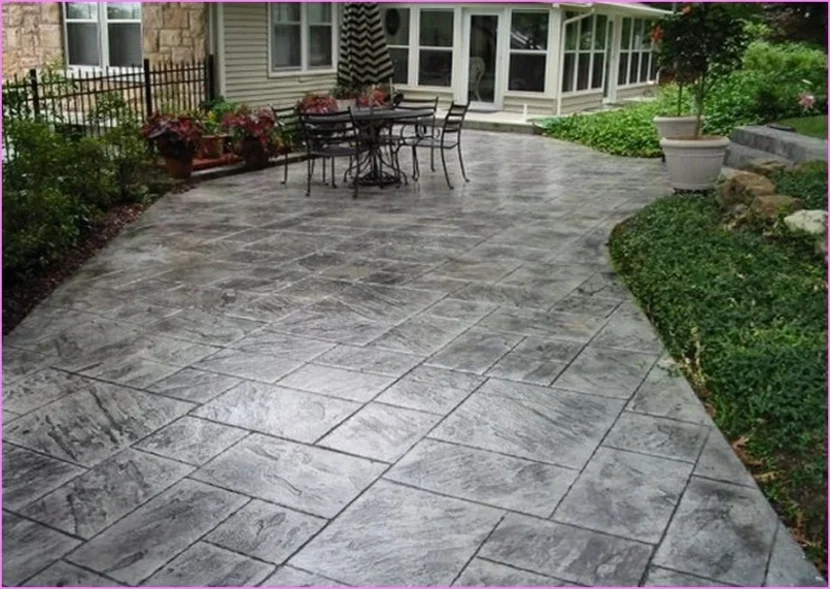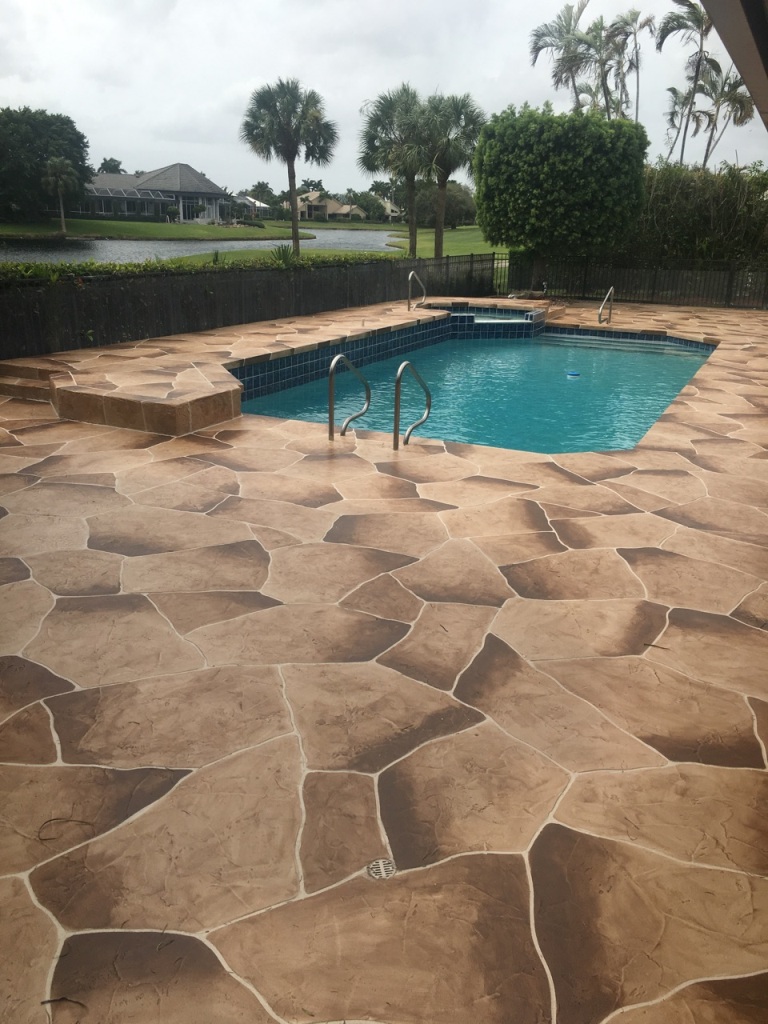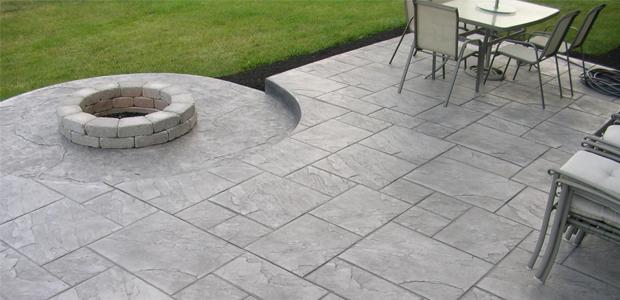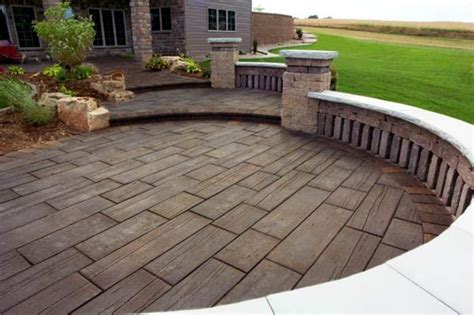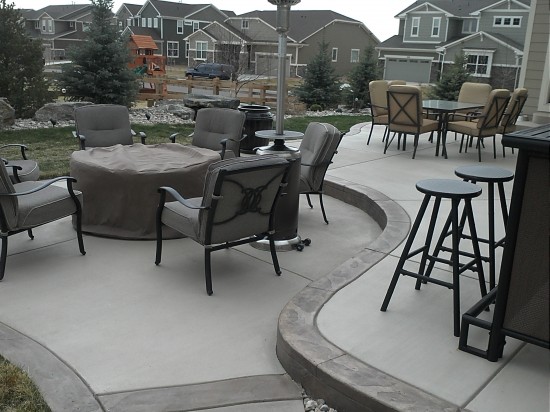What Is The Lifespan Of Stamped Concrete?
What Is The Lifespan Of Stamped Concrete?
Concrete has been a popular choice for building materials since the dawn of civilization. It is now used in many forms, from traditional poured concrete to stamped concrete – providing a durable and aesthetically pleasing surface that can stand the test of time. But how long does stamped concrete last? How much wear and tear will it withstand before needing to be replaced? In this article, we explore the lifespan of stamped concrete and discover how you can make sure your surface stands strong against Mother Nature’s elements.
Stamped concrete has become increasingly popular over recent years due to its ability to mimic natural paving surfaces such as stone or brick. This type of decorative material provides an attractive addition to driveways, patios, pool decks, walkways and other outdoor areas. The secret behind its longevity lies in its strength – achieved by mixing cement with aggregates and water before stamping it into desired shapes with specialized moulds. When cured correctly, stamped concrete offers superior durability compared to other exterior floor finishes.
When exposed to harsh weather conditions or extreme temperatures, however, even the toughest materials require maintenance. So what are some factors that affect the lifespan of stamped concrete? And how can you ensure your project lasts for years without requiring repairs? Read on for answers to these questions and more about maintaining your stamped concrete surface.
Stamped Concrete Life Expectancy Is 25 Years
The incredible durability of stamped concrete has made it the go-to choice for many outdoor design projects. Its life expectancy is an astonishing 25 years, and this remarkable resilience makes it a superior option when compared to other hardscaping materials such as pavers or traditional, poured concrete. This staggering longevity means that your stamped concrete project will last far beyond its initial installation – providing beauty, utility and peace of mind for decades to come!
Due to its long lifespan, stamped concrete requires little maintenance over the course of its lifetime. While regular sealing can help extend the life of any concrete surface, stained and sealed stamped concrete needs minimal care in order to retain its original vibrancy and luster. After all, no one wants their carefully designed stamped concrete patio to look dull and faded after just a few short years! Regular cleaning with mild soap and water is usually enough to keep your patio looking like new.
Coupled with its durable nature, stamped concrete also offers unparalleled versatility when it comes to shape and color options. With proper planning, you can create virtually any look imaginable with colored stains – from rustic brick patterns to sleek modern designs – all while making sure that your investment remains strong through time. Stamped Concrete truly stands out among the rest; offering unrivaled strength against wear and tear while still allowing homeowners to express their creativity through imaginative design choices.
What Affects The Lifespan Of Stamped Concrete?
The life expectancy of stamped concrete is a key factor in determining whether to use it for a surface or not. Stamped concrete can last up to 25 years if properly maintained, but the lifespan may vary depending on the situation and environment. Factors such as foot traffic, climate conditions, cleaning methods, sealers used, and installation techniques all impact how long stamped concrete will last.
One critical factor that affects the longevity of stamped concrete is regular maintenance. Failing to clean and reseal surfaces with high foot traffic regularly can reduce their lifespan significantly. Other issues such as exposure to harsh chemicals or frequent freeze-thaw cycles could also decrease the life span of stamped concrete.
In comparison, pavers are considered more durable than stamped concrete when exposed to extreme temperatures or heavy loads due to their interlocking design; however, they require more maintenance since weeds need to be removed from between them. Ultimately, understanding what affects the lifetime of a material like stamped concrete is essential for making informed decisions about which type of flooring would be best suited for any given project.
How To Make Stamped Concrete Last Longer
To make stamped concrete last longer, one must be willing to embark on a journey of proper installation and maintenance. To best illustrate this process, imagine you are standing in front of a beautiful home with an inviting concrete patio that was recently installed using stamped concrete technology. The homeowner is proud of the new addition to their property and wants it to remain looking its best for as long as possible.
The key to making stamped concrete last longer is ensuring that it has been properly installed and maintained throughout its lifespan. This includes applying sealants every two years or so, regularly inspecting the surface for any signs of wear and tear such as cracks or fading colors, and cleaning up spills promptly. Additionally, if there are areas where water tends to pool, those sections should be addressed before further damage can occur by sealing them off with additional layers of sealant or waterproofing material. Doing these things will help ensure that your stamped concrete patio lasts for many years without needing costly repairs or replacements down the line.
Each step taken towards keeping your stamped concrete looking its best will result in more years spent admiring your investment from afar – all while saving money at the same time! With some patience and attention paid to detail when installing and maintaining your newly-laid stamped concrete surface, you can extend the lifecycle significantly compared to not taking any action at all.
How To Winterize Stamped Concrete
Stamped concrete is a decorative form of concrete often used for patios, driveways, and other outdoor surfaces that can add an aesthetically pleasing touch to any home. Surprisingly, however, it does not last forever — no matter how much effort goes into its installation or maintenance. Winterizing stamped concrete is essential in order to extend the lifespan of this material as long as possible.
The process of winterizing stamped concrete begins with preparing the surface by cleaning off loose debris and dirt from the area. This will ensure that all cracks and crevices are visible so they can be sealed properly. Afterward, silicone-based sealers should be applied liberally over all areas where water may collect during the colder months such as around steps, pools, fountains, and any other potential points of leakage. Additionally, applying a coat of wax to the entire surface helps protect against UV damage throughout the year.
For those looking to save on costs while still protecting their investment in decorative concrete stamps, using a layer of mulch or gravel between walkways and flower beds creates an extra barrier from freezing temperatures without breaking the bank. Furthermore, paying close attention to snow removal is also important; shoveling away excess accumulation before it has time to melt and freeze again keeps pathways safe while preventing further wear on your beautiful stamped concrete cost project.
How To Maintain Stamped Surfaces
Maintaining stamped concrete surfaces is a crucial step in ensuring the longevity and value of your home. These surfaces, while having relatively long lifespans compared to other materials, need proper maintenance if they are to remain restored to their original condition. When considering the lifespan of stamped concrete, it is important to understand how best to maintain its surface over time.
The first step in maintaining any stamped concrete surface is regular cleaning. This removes dirt and debris that can accumulate over time and cause damage or discoloration. It also helps prevent mildew growth which can further degrade the material’s integrity. In addition, sealing the stamped concrete will help protect it from UV rays and moisture which can lead to cracking or fading as well as preventing staining from oil or grease spills. Applying sealant should be done every two years for optimal results.
Repairing damaged areas quickly is another key factor when looking at the lifespan of stamped concrete surfaces. Over time these surfaces may experience wear or even structural problems due to shifting soil beneath them but taking action early on can often restore them back to working order with minimal effort required. Additionally, inspecting regularly for such damages is an effective way of catching any issues before they worsen significantly, thus prolonging the life of your investment and adding value to your home overall.
In summary, properly maintained stamped concrete surfaces have a high potential for lasting many years without needing significant repairs or replacements – provided that routine cleaning and sealing as well as prompt repair work occur throughout its lifetime. By following these steps, homeowners can ensure that their investment lasts longer and maintains its original aesthetic appeal.
5 Tips For Maintaining Stamped Concrete
Stamped concrete is a popular choice for many home and business owners due to its versatility, durability, and aesthetic appeal. However, in order to ensure that stamped surfaces last longer, there are certain maintenance tips that should be kept in mind. Properly maintaining stamped concrete can help extend the lifespan of this surface significantly.
From sweeping
Is Stamped Concrete Cheaper Than Concrete?
Is Stamped Concrete Cheaper Than Concrete?
Stamped concrete is a popular and attractive finishing option for many outdoor projects. It can be used to create walkways, driveways, patios, pool decks and other features in the landscape of a home or business. As with any construction project, cost is an important factor when deciding what material to use. This article will explore whether stamped concrete is cheaper than regular concrete when it comes to completing such projects.
The process of stamping involves pressing molds into fresh wet concrete to create designs that simulate brick, stone or tile surfaces. The pattern created by this process adds visual appeal but also increases labor costs associated with its installation compared to traditional poured concrete surfaces. Additionally, there are more materials needed for this type of work which could increase installation costs further.
There are several factors which need to be considered when determining whether stamped concrete is a more affordable option than conventional concrete; these include the cost of materials and labor as well as the design desired for the finished product. Through analysis of these elements, one can make an informed decision about the most cost effective choice for their particular project needs.
Overview Of Stamped Concrete
Stamped concrete has become a popular choice for many home and business owners due to its cost-effectiveness, durability and ease of installation. It is created by pressing pre-formed stamps into wet concrete while it is still in the setting stage. As a result, stamped concrete can replicate the look of brick and other natural materials at a fraction of the cost. In addition, this type of material offers low maintenance requirements compared to other options such as pavers or stone patios.
The primary benefit of using stamped concrete is that it can give projects an elegant finish without having to spend too much money on expensive materials like natural stone or wood. Stamped concrete can be used for driveways, patios and decks, walkways and pool surrounds with patterns resembling flagstone, cobblestone and slate. Furthermore, colored powder pigments are added during the mixing process to provide unique color combinations that will create aesthetically pleasing results.
Not only does stamped concrete offer excellent value for money but also requires less upkeep than regular poured concrete or paver patio surfaces which require periodic cleaning and sealing treatments to maintain their appearance over time. Moreover, when properly installed and maintained, it can last up to 25 years before needing any major repairs.
What Is Stamped Concrete?
While there is a common misconception that stamped concrete is more expensive than standard concrete, this isn’t necessarily true. Stamped concrete can actually be an affordable paving material when compared to interlocking pavers or other materials used in driveways and patios. Understanding what stamped concrete is and its associated costs will help make the decision easier.
Stamped concrete involves pouring wet concrete into forms on a surface area such as a driveway or patio and then applying textured mats onto it before the cement hardens. This results in an imprinted pattern that mimics brick, stone, slate, wood planks, etc., giving it a distinct look from traditional poured surfaces. The cost of installing stamped concrete varies depending on factors like size of project and difficulty of job but averages around $15 per square foot for most projects with some costing up to $25 per square foot. While this may seem high at first glance, compare it to the cost of interlocking pavers which can range from $20-$30 per square foot installed – making stamped concrete often times cheaper overall.
Before deciding between standard poured concrete or stamped concrete for your driveway or patio space consider all the options available and their associated costs. Weighing out pros and cons of each option will help you determine which one best fits both your budget and aesthetic needs…
Benefits Of Stamped Concrete
Stamped concrete is a type of decorative concrete product that involves pressing patterns into freshly-poured concrete slabs. This process can be used to replicate the look of traditional materials such as brick, stone or tile, but with the durability and longevity of poured concrete. It provides homeowners with an affordable way to add value to their property while creating unique visual elements in areas such as driveways, patios or walkways.
The benefits of stamped concrete are numerous when compared to other options like pavers or poured concrete. Stamped concrete requires less maintenance than both forms of paving since it does not have any seams between pieces which can allow water to seep through and cause damage. Furthermore, because its design already includes texture, it can provide slip resistance without needing additional sealants. As well, due to its versatile nature, stamped concrete comes in various colors and patterns that help hide dirt and wear more effectively than standard poured varieties do. Additionally, professional installation from certified contractors will ensure lasting quality for years to come.
In comparison to installing individual stones or bricks on top of a layer of sand or gravel, stamped concrete offers a cost effective alternative that doesn’t require regular upkeep or replacement over time. With proper care and maintenance by professionals who specialize in this form of work, homeowners can enjoy the beauty and strength associated with this material at much lower costs than they would expect from using traditional materials like tiles or pavers.
Cost Factors For Stamped Concrete
Stamped concrete is a popular choice among homeowners for outdoor living areas as it offers the look of natural stone or brick. Although this type of decorative concrete may seem expensive, when comparing installation costs with plain concrete, there are several cost factors to consider.
When weighing up whether stamped concrete is cheaper than plain concrete, it should be acknowledged that hiring experienced contractors and paying for quality materials will increase overall expenditure. However, many people find that they can save money in other places due to how quickly stamped concrete can be installed compared to traditional paving methods. This means fewer labor hours required and often times less waste material generated during the process due to its precise nature. Additionally, given the fact that no additional sealants are needed after installation and long-term maintenance costs are usually lower in comparison with alternative options such as tile or pavers, these savings over time can add up significantly.
On top of those advantages, designers have access to an array of colors and patterns which enables them to create stunning effects without incurring higher expenses than if they were using regular poured concrete instead. With all things considered, stamped concrete proves itself not only aesthetically pleasing but also more economically viable than other alternatives available on the market today. Thus, making an informed decision about your next project could lead you towards achieving great results at reasonable prices.
Cost Comparison: Stamped Concrete Vs. Plain Concrete
From a cost perspective, it is important to consider the comparison between stamped concrete and plain concrete. For many homeowners, understanding the difference in pricing can be an essential factor when deciding what type of material to use for any given project. By exploring both options further, one can understand not only the cost differences but also which option is more suitable for their needs. Simile speaking, comparing purchasing stamped concrete versus plain concrete is like choosing between apples and oranges; each has its own unique properties that make them advantageous (or disadvantageous) depending on the application.
When evaluating cost comparisons between stamped and plain concrete, it’s useful to look at factors such as initial installation costs, maintenance requirements, and longevity in order to determine overall value for money spent. Initial installation costs are typically higher with stamped concrete than with regular concrete due to the extra labor involved in creating decorative patterns or textures. However, this expense may be offset by fewer long-term repair or replacement costs if you opt for stamped rather than plain because stamping increases durability and resistance against weather effects such as cracking or fading over time. Furthermore, periodic maintenance requirements tend to be less frequent with stamped surfaces compared to those made from traditional materials since they generally need less sealing and resealing during their lifespan.
Therefore, while initially more expensive, stamped concrete could actually be considered more economical over time due to increased durability and reduced maintenance expenses compared to standard concretes. Additionally, when assessing total cost implications of using either material in construction projects: aesthetics should also play a significant role since decorative elements provide greater design flexibility along with enhanced visual appeal. Ultimately then, considering all these factors together will help individuals make informed decisions about which material provides better value according to their individual circumstances – ensuring they make choices that are most beneficial financially while still achieving desired outcomes aesthetically too.
Is Stamped Concrete Cheaper Than Concrete?
Stamped concrete is a type of decorative concrete that provides a more aesthetic finish to plain concrete. The cost comparison between stamped and plain concrete involves several considerations such as the materials … Read the rest

